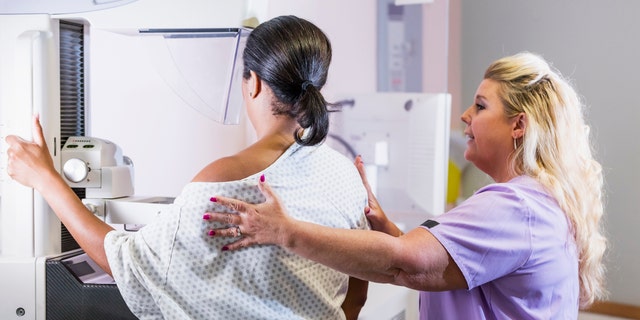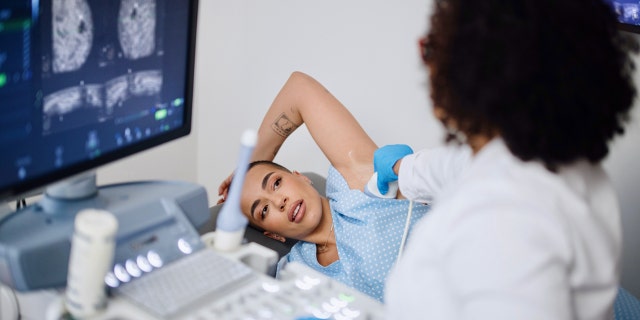
The U.S. Preventive Services Task Force (USPSTF), based in Rockdale, Maryland, has released a draft of new guidelines for breast cancer screenings, recommending that women begin getting mammograms every other year starting at the age of 40.
The new guidelines apply to women who are deemed at “average risk,” which includes those who have a family history of the disease and who have dense breast tissue or other risk factors.
The previous recommendation, which was released in 2016, called for women to start screenings at age 50 — stating that women younger than 50 could choose to screen earlier based on their medical history and personal preferences.
THE MAJOR CHANGE IN BREAST CANCER SCREENING AIMED AT SAVING YOUNG WOMEN
The new guidance from USPSTF is closer to that of the American Cancer Society, which says that women between 40 and 44 should have the choice to begin getting biennial screenings and that women between 45 and 54 should ramp up the frequency to every year.

The U.S. Preventive Services Task Force has released a draft of new guidelines for breast cancer screenings, recommending that women begin getting mammograms every other year starting at the age of 40. (iStock)
The USPSTF is seeking public comments on its draft recommendation until June 6.
“Women in their 40s account for 20% of all breast cancers.”
“New and more inclusive science about breast cancer in people younger than 50 has enabled us to expand our prior recommendation and encourage all women to get screened every other year starting at age 40,” said the Task Force’s immediate past chair, Carol Mangione, M.D., in a press release announcing the new recommendations.

The previous recommendation, which was released in 2016, called for women to start screenings at age 50. (iStock)
“This new recommendation will help save lives and prevent more women from dying due to breast cancer,” the statement continued.
AI TECHNOLOGY USED TO READ MAMMOGRAMS COULD PUT PATIENTS AT POTENTIAL RISK: STUDY
The USPSTF is an independent panel of national experts in “prevention and evidence-based medicine” that makes “evidence-based recommendations” about preventive health services, including disease screenings, mental health counseling, medications and other services.
Providers in support of new guidelines
Hackensack Meridian Health in New Jersey has already been recommending screening mammograms for average-risk women at ages 40 and above, said Dr. Harriet Barofsky, medical director of breast imaging at the Hackensack Meridian Riverview and Bayshore Medical Centers.
CHATGPT ANSWERED 25 BREAST CANCER SCREENING QUESTIONS, BUT IT’S ‘NOT READY FOR THE REAL WORLD’ — HERE’S WHY
This guidance was based on evidence from randomized controlled trials and guidelines from the National Comprehensive Cancer Network, the American College of Radiology, the Society of Breast Imaging and the American College of Obstetricians and Gynecologists, Barofsky told Fox News Digital.

Each year in the U.S., about 264,000 cases of breast cancer are diagnosed in women and some 42,000 women die of the disease, according to the CDC. (iStock)
“Women in their 40s account for 20% of all breast cancers,” the doctor said.
“Early detection with annual mammograms is hugely impactful for this age group, as their tumors tend to be the more aggressive and they have the most potential years of life.”
FDA ISSUES NEW MAMMOGRAM REGULATIONS AIMED AT FURTHER BREAST CANCER PREVENTION
“The benefits of screening, such as halting the natural progression of cancer, increasing treatment options that are well-tolerated and saving lives, far outweigh the risks of false positives, which can be resolved with additional imaging and biopsies,” Barofsky added.
CLICK HERE TO SIGN UP FOR OUR HEALTH NEWSLETTER
In March, the U.S. Food and Drug Administration (FDA) released updated regulations that require mammogram providers to notify patients about the density of their breast tissue, which is an important risk factor for cancer.
CLICK HERE TO GET THE FOX NEWS APP
Each year in the U.S., about 264,000 cases of breast cancer are diagnosed in women and some 42,000 women die of the disease, according to the CDC.

 Latest Breaking News Online News Portal
Latest Breaking News Online News Portal




